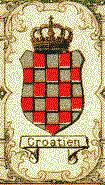 checquy Argent and Gules. The first known example dates from 1491,
and it was used officially in 1527 when the Croat Estates chose Ferdinand
of Habsburg as king. They remained the arms of Croatia in the Habsburg
achievements until 1918.
checquy Argent and Gules. The first known example dates from 1491,
and it was used officially in 1527 when the Croat Estates chose Ferdinand
of Habsburg as king. They remained the arms of Croatia in the Habsburg
achievements until 1918. More ample information about the history of the former Yugoslavia can be found in the Yugoslavia Army Area Handbook. There is also a Yugoslav Home Page. For heraldry, see also:
First, there was the Byzantine empire, whose arms are discussed elsewhere. A number of slav tribes had settled in the Balkans in the 7th century, and slowly moved out of the direct domination of the Byzantines. Thus emerged Valachia (to become Rumania), Serbia, Croatia. In fact, Slovenia and Croatia were never really in the sphere of influence of the Byzantine empire, as their alphabet (Roman) and their religion (Catholic) suggest. Later, some regions gained partial or full autonomy: Slavonia, Bosnia, Dalmatia, etc. When the Turks started invading Europe in the 14th century, these small fiefs and kingdoms lost their independance one after the other. With the end of the Ottoman Empire starting in the early 19th century, they re-emerged one after the other, except Slovenia and Croatia still under Austrian rule. After 1918, Yugoslavia was created as a kingdom, uniting all Southern Slavs for the first time. It became "sort of communist" after 1945. We all know the current state of affairs.
As far as heraldry is concerned, it seems that the lands which were in the sphere of influence of Hungary, Austria or Venice developed an indigenous heraldry in the Middle Ages (Slovenia, Croatia, Dalmatia, Bosnia). In particular, in Croatia and along the coast, heraldry had extended from dynastic families to nobility and commoners as well. After the Turkish empire receded, the same territories became part of the Austrian Empire, and their heraldry appears in the volumes of Siebmacher.
As a kindgom (1918-1945), ruled I think by the Serbian royal family, it had its arms. Namely: Gules, a double-headed eagle Argent, beaked, membered and tongued Or, bearing an escutcheon: tierced per pairle inversed, Serbia, Croatia, and Azure, a crescent Argent below three stars Or per fesse. (see an illustration).
Gules, two fleur-de-lys Or below a double-headed eagle Argent, beaked, membered and tongued Or, bearing an escutcheon: Gules, a Cross Argent between 4 B's (or firesteels) Or. There are variants on the escutcheon: in some cases, the horizontal arms of the cross bear the dates 1389 and 1817, and there is a sword Or per pale on the cross. 1389 is the battle of Kosovo, when the Serbs lost their independence. 1817 is the date they regained their autonomy. In the arms of Yugoslavia above, "Serbia" refers to the simple version of the escutcheon with cross and 4 B's. Serbia emerged in 1817 as an autonomous province of the Ottoman Empire and became a full-fledged kingdom in 1882. These arms were used from 1882 to 1918. I suspect the cross with 4 Bs are now being used again, if only informally.
Aleksandar Stojsic provided me with some pictures; see also illustrations on the Web site of HRH Alexander of Yugoslavia.
 checquy Argent and Gules. The first known example dates from 1491,
and it was used officially in 1527 when the Croat Estates chose Ferdinand
of Habsburg as king. They remained the arms of Croatia in the Habsburg
achievements until 1918.
checquy Argent and Gules. The first known example dates from 1491,
and it was used officially in 1527 when the Croat Estates chose Ferdinand
of Habsburg as king. They remained the arms of Croatia in the Habsburg
achievements until 1918.
In the 9th c. the Croats form a political entity, and their leader takes the title of king in 925. In 1102, a succession crisis is solved with the choice of the king of Hungary as king of Croatia. The two kingdoms are ruled by the same ruler until the Turkish conquest in 1526, though Croatia retains its institutions, its governor or ban, and its coinage. On medieval coinage, the arms of Croatia appear to be a mullet of six over a crescent (the motif appears on coins as early as 1196). This motive of the star and crescent later emerged in the 16th c. as the alleged coat of arms of "Illyria" (an area meant to include most of the Balkans), in the form Gules a crescent beneath an 8-pointed star argent. The morning star was called Danica, and the crescent-and-star motive was known as Leljiva in the 19th c.
The chequy arms were used on the flag of the puppet regime in 1941-45, but (interestingly) they also appeared on the seal of the republic of Croatia after 1946.
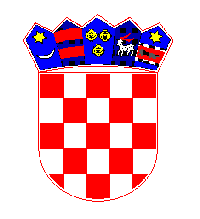 Since independence in 1991, the Republic of Croatia uses, in addition,
their provincial arms as a crown above the escutcheon. There are five shields,
each bearing arms of a particular province.
Since independence in 1991, the Republic of Croatia uses, in addition,
their provincial arms as a crown above the escutcheon. There are five shields,
each bearing arms of a particular province.
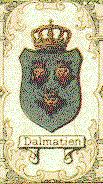 Azure,
three lions' heads crowned cabossed or (Dalmatia)
Azure,
three lions' heads crowned cabossed or (Dalmatia)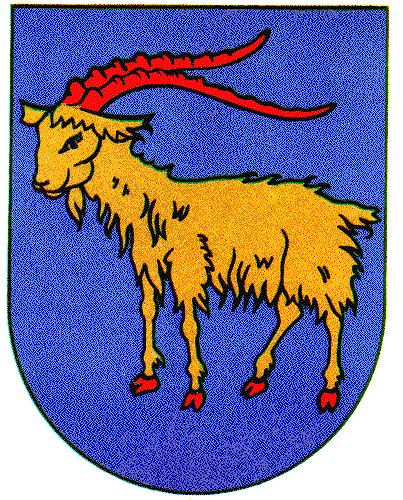 Azure,
a goat stantant Or, armed, hooved and langued Gules (Istria)
Azure,
a goat stantant Or, armed, hooved and langued Gules (Istria)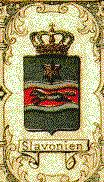 Azure,
a river in fesse gules, bordered argent, thereon a weasel, or marten passant
proper beneath a 6-pointed star or. (Slavonia)
Azure,
a river in fesse gules, bordered argent, thereon a weasel, or marten passant
proper beneath a 6-pointed star or. (Slavonia)The arms of Slavonia were officially granted by Wladyslaw II Jagiello, king of Bohemia and Hungary, in 1496, but in fact they appear on coins of Slavonia as early as 1235. The arms of Istria and Dalmatia are the traditional ones. The arms of Dubrovnik (or Ragusa) differ from those used by the Republic of Ragusa until 1797.
 These
are the modern arms of the Republic of Slovenia. Until it became independent
in 1991, Slovenia never really existed as a distinct political entity.
It was early on incorporated into the Habsburg's possessions. Modern Slovenia
is made up of Crain (Krain in German, Kranjska in Slovenian), and parts
of Steiermark (most of which is in Austria), and parts of Istria. These
lands had the following arms:
These
are the modern arms of the Republic of Slovenia. Until it became independent
in 1991, Slovenia never really existed as a distinct political entity.
It was early on incorporated into the Habsburg's possessions. Modern Slovenia
is made up of Crain (Krain in German, Kranjska in Slovenian), and parts
of Steiermark (most of which is in Austria), and parts of Istria. These
lands had the following arms:
 Istria:
Azure, a goat stantant Or, armed, hooved and langued Gules;
Istria:
Azure, a goat stantant Or, armed, hooved and langued Gules;  Crain:
Argent an eagle displayed Azure, crowned Or, langued and armed Gules,
with a crescent checquy Or and Gules on its breast.
Crain:
Argent an eagle displayed Azure, crowned Or, langued and armed Gules,
with a crescent checquy Or and Gules on its breast.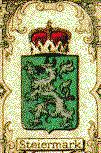 Steiermark:
Vert, a panther clymant Argent, armed and tongued Gules.
Steiermark:
Vert, a panther clymant Argent, armed and tongued Gules. Genealogy and Heraldry in Slovenia is a site maintained by Tomaz Pisanski.
It existed as a separate entity in the Middle Ages, resurrected in 1908 as a kingdom. From 1908 to 1918 it had the following arms: Gules, a double-headed eagle Argent beaked, membered and tongued Or, bearing an escutcheon: Azure, a lion passant Or on a champagne Vert.
The Montenegrin Association of America has a picture of the arms and flag of Montenegro.
Visit the Bosnia Homepage: some of the pictures on this page come from there. There is also a page of Bosnian flags and heraldry, including the flag of the Croat-Muslim federation.
 Azure, a
bend argent between 6 fleur-de-lys or. The origin of these arms, which
were on the flag of the republic of Bosnia and Herzegovina
until 1999, has long puzzled
me, but they are in fact the arms of the Kotromanic family, which ruled
Bosnia in the 14th and 15th centuries. Other arms have also been attributed
to Bosnia in the 19th century.
Azure, a
bend argent between 6 fleur-de-lys or. The origin of these arms, which
were on the flag of the republic of Bosnia and Herzegovina
until 1999, has long puzzled
me, but they are in fact the arms of the Kotromanic family, which ruled
Bosnia in the 14th and 15th centuries. Other arms have also been attributed
to Bosnia in the 19th century.
I finally thought of a way to get at this question of the origin of the current Bosnian flag: numismatics, of course. I found a book by one Ivan Rengjeo, Corpus der mittel-alterlichen Münzen von Kroatien, Slavonien, Dalmatien und Bosnien, Graz, 1959, which is as exhaustive as you can get on the topic (coins from those regions, that is). I have also consulted an article by Pavao Andelic on Medieval Seals of Bosnia-Hercegovina, in the monograph series of the Academy of Sciences and Arts of Bosnia-Hercegovina (Sarajevo, 1970), but it is in Serbo-Croat, so I can only look at the (numerous) illustrations. What follows is a historical/heraldic account, pieced together from these sources, and a few encyclopedias.
There is a Bosnia site which contains pictures of some of the seals and coins of the Bosnian kings which I discuss here.
Bosnia was dominated alternatively by Serbia and, from the 12th c. onward, by Croatia (in personal union with Hungary) until the early 14th c. Typically, the king of Hungary and Croatia appointed bans, or local governors; and, in typical medieval fashion, these bans took advantage of any weakness of the central monarchy to carve out territories for themselves.
In the early 14th c., the ban of Croatia was Pavao (Paul) Subic of Brebir or Breberio (a town in Dalmatia which was given to the family in 1222): his father and grandfather were counts or Trau or Trogir, his cousins were counts of Spalato or Split. This powerful man titles himself ban of Croatia and dominus Bosniae , and appoints his brother Mladen I Subic (1302-04) and later his eldest son Mladen II (1312-14) as ban of Bosnia. His second son Georg was count of Trau and Split, his third son Pavao was count of Trau. By the third generation, however, the family had lost its power. This first dynasty of bans issued byzantine-style coins, with no heraldry. Their seals, however, show the Subic arms: an eagle wing displayed, and 5 flowers with stems as crest (misread by Siebmacher as ostrich-feathers). The style of the arms is very German, with the shield tilted to the left, a German helm, lambrequins, and a crest. There are no tinctures, but a junior branch issued from Pavao count of Trau, the Subic de Zrin, bore Gules, two wings sable (an interesting violation of the so-called tincture rule).
Pavao Subic was forced to cede control of Southern Bosnia to Stjepan Kotromanic (died 1353); and, in 1314, Mladen II ceded the banate of Bosnia to him. This established the Kotromanic dynasty in Bosnia. Stjepan styles himself dei gratia Bosniae banus, which asserts a fair measure of independence. Stjepan's brother Vladislav married Helena, daughter of Mladen II Subic, and their son Stjepan Tvrtko (1353-91) succeeded Stjepan. In 1377, Tvrtko assumed the title of King of Racia and Bosnia. His seals show the following arms: a bend between six fleurs-de-lys, the helm is a hop-flower on a long stem issuant from an open crown of fleurs-de-lys.
The Kotromanic were close to the Hungarian kings, and Stjepan's daughter Elisabeth married Louis I of Hungary (reigned 1342-82).
Trvtko I was succeeded by his half-brother Stjepan Dabisa (1391-95) and his son Stjepan Ostoja (1398-1404, 1409-18) and grandson Stjepan Ostrojic (1418-21). The seal of Stjepan Ostoja shows different arms, namely an open crown of fleurs-de-lys and the same helm and crest as before. Another son of Tvrtko I was Tvrtko II (1404-09, 1421-43), who used a seal similar to his father's, with the arms of the Kotromanic family itself, which are the bend between 6 fleur-de-lys, a crowned helm with the same crest. New coins are issued starting in 1436, markedly Western in style, which display a full-blown achievement: an escutcheon bearing the letter T, crowned with an open crown of fleur-de-lys. The helm is crowned and the crest is a hop-flower on a long stem. The letter T seems to stand for the name of the king. Later, around 1450, impressive new gold coins show the Kotromanic arms.
The last kings, descended from Stjepan Ostoja, are Stjepan Tomas Ostojic (1444-61) and his son Stjepan Tomasevic (1461-63). The kingdom disappears in 1463 when he is killed by the Turks. In the southern region called Hum or Chelm, a local ban called Stjepan Vukcic Kosaca (died 1466) had proclaimed himself duke or herceg in 1448, and is recognized by the Holy Roman Empire as duke of Saint-Abbas or Saint-Sava in some texts (whence the name Hercegovina for that area). Siebmacher says that the family was descended from the Byzantine Comneno.
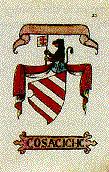 The
Vukcic family arms appear on the seal of Stjepan Vukcic, and his successors
Vladislav Hercegovic (died 1489) and Vlatko Hercegovic (died 1489): namely
Gules, three bends argent, crest: a lion issuant holding in its
two paws a banner gules with a double cross argent (the Hungarian state
banner, according to Siebmacher). The same arms appear on coins issued
by a self-proclaimed duke of Split in the early 15th c., namely on a bend
between two crosses, three fleur-de-lys bendwise.
The
Vukcic family arms appear on the seal of Stjepan Vukcic, and his successors
Vladislav Hercegovic (died 1489) and Vlatko Hercegovic (died 1489): namely
Gules, three bends argent, crest: a lion issuant holding in its
two paws a banner gules with a double cross argent (the Hungarian state
banner, according to Siebmacher). The same arms appear on coins issued
by a self-proclaimed duke of Split in the early 15th c., namely on a bend
between two crosses, three fleur-de-lys bendwise.
The remaining question is: where did the fleur-de-lys in the Kotromanic (and the Vukcic) arms come from? One distinct possibility is Byzantium, whose style the first Bosnian coins imitate closely. Byzantine emperors started using the fleur-de-lys on their coinage soon after the creation of the empire of Nicaea, after the fall of Constantinople in 1204.
But more realistically, the connection would be with the Hungarian dynastic struggle which broke out in 1302 with the end of the Arpad dynasty. The kings of Naples claimed the throne, and it was during the struggle that, by pledging alliegance to one side and to the other, the Bosnian bans managed to carve out their independent fief. The Bosnian dynasty became quite close to the Angevins, and the daughter of Stjepan, king of Bosnia, married Louis I, king of Hungary. The kings of Naples were the Anjou family, a junior branch of the French royal family, and bore France differenced with a label gules. I can well imagine the Kotromanic adopting, or being granted, fleur-de-lys on their coat of arms as reward for taking the Angevin side. For the moment, Bosnian history books are hard to come by, so I can't easily confirm my hunch. For some reason, these arms were forgotten after the 16th century.
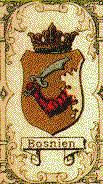
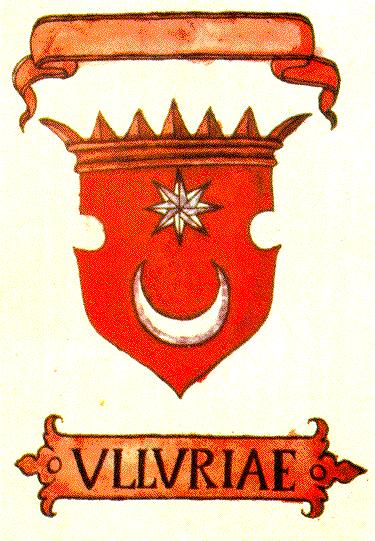 Since
the 16th century, other arms have been attributed to Bosnia. An armorial
of 1595, apparently forged by an social-climbing Bosnian serving in Spain
to improve his pedigree, purports to be a copy of the armorial of a herald
of the Serbian Czar Stipan Nemanjic. It contains a number of coats of arms
for the various territories of his empire, as well as coats of arms of
noble families. A copy in Zagreb (the Korjenic-Neoric armorial) was used
by Siebmacher as a source. Some of the territorial arms appear to come
from the armorial of Virgil Solis (Nürnberg, 1555). That armorial
attributes the following to Bosnia: argent two keys (or a bend and a
bend sinister ecotee) per saltire gules, charged in chief each with a Moor's
head crowned or.
Since
the 16th century, other arms have been attributed to Bosnia. An armorial
of 1595, apparently forged by an social-climbing Bosnian serving in Spain
to improve his pedigree, purports to be a copy of the armorial of a herald
of the Serbian Czar Stipan Nemanjic. It contains a number of coats of arms
for the various territories of his empire, as well as coats of arms of
noble families. A copy in Zagreb (the Korjenic-Neoric armorial) was used
by Siebmacher as a source. Some of the territorial arms appear to come
from the armorial of Virgil Solis (Nürnberg, 1555). That armorial
attributes the following to Bosnia: argent two keys (or a bend and a
bend sinister ecotee) per saltire gules, charged in chief each with a Moor's
head crowned or.
 The same armorial also blazons Primorje (the littoral region now part of
Croatia) as Gules a an arm dexter embowed vambraced holding a scimitar
argent. These arms were later also used for the Bosnian province of
Rama. A version of these arms find their way into a 18th c. French genealogy
of the Angevin kings of Hungary where the arms of Louis' Bosnian wife are
blazoned as: Or, issuing from the sinister flank an arm embowed proper,
vested Gules, holding a sabre Argent. These are also the arms attributed
by the Austrians to the whole of Bosnia-Hercegovina after it was annexed
from Turkey in 1908. However, a number of 19th century encyclopedias (for
example, the French Larousse or Siebmacher) attribute to Bosnia the "arms
of Illyria" ( Gules, a crescent Argent beneath an 8-pointed star
of the same.) The crown over the shield is an Eastern crown, i.e. with
"spikes". These arms recall the old symbol of Croatia on its
early coinage.
The same armorial also blazons Primorje (the littoral region now part of
Croatia) as Gules a an arm dexter embowed vambraced holding a scimitar
argent. These arms were later also used for the Bosnian province of
Rama. A version of these arms find their way into a 18th c. French genealogy
of the Angevin kings of Hungary where the arms of Louis' Bosnian wife are
blazoned as: Or, issuing from the sinister flank an arm embowed proper,
vested Gules, holding a sabre Argent. These are also the arms attributed
by the Austrians to the whole of Bosnia-Hercegovina after it was annexed
from Turkey in 1908. However, a number of 19th century encyclopedias (for
example, the French Larousse or Siebmacher) attribute to Bosnia the "arms
of Illyria" ( Gules, a crescent Argent beneath an 8-pointed star
of the same.) The crown over the shield is an Eastern crown, i.e. with
"spikes". These arms recall the old symbol of Croatia on its
early coinage.
There is some evidence for a medieval use of the shield with the arm holding a saber as the arms of Primorje. William Miller, in Essays on the Latin Orient (Cambridge, 1921, p.510) describes the arms displayed in Rome on the tomb of Catherine (died 1478), daughter of Stjepan Vukcic duke of Saint-Abbas, and married in 1446 to Stjepan Tomas Kotromanic, last king of Bosnia (d. 1461): his description is unfortunately imprecise, but he mentions two horsemen (which he says is the Kotromanic emblem) and a "mailed arm with a sword in the center" as arms of Primorje.
Some of the confusion surrounding the arms of Bosnia clearly stems from geographic confusion. The modern state of Bosnia, by linking with the medieval kingdom of Bosnia, clearly aimed to sidestep the tangled traditions which have cropped up while Bosnia was under Turkish rule.
The following blasons come from Siebmacher's volume on Dalmatia.
Dalmatia: Gules, three leopards' heads affrontes argent, langued and crowned or. (From Konrad von Grueneberg's armory of the Constance Council, 1483).
 Dalmatia: Azure, three leopards' heads affrontes, crowned or, langued
gules. (Siebmachers Wappenbuche, old edition; this was the version
used in the Austrian state arms).
Dalmatia: Azure, three leopards' heads affrontes, crowned or, langued
gules. (Siebmachers Wappenbuche, old edition; this was the version
used in the Austrian state arms).
Dalmatia (under Venetian rule): quarterly, 1: Gules, three leopards' heads affrontes crowned or, langued gules (Dalmatia); 2: chequy Argent and Gules (Croatia); 3: Or, three horseshoes inverted sable (kingdom of Rascia); 4: Argent (or Or), a lion gules armed and langued azure (kingdom of Albania).
Dalmatia (under Napoleonic rule): Gules, three leopards' heads affrontes or. (shown as escutcheon of pretence on the arms of marechal Soult, duke of Dalmatia).
 Illyria
(old arms): Gules, a silver crescent beneath an 8-pointed star argent.
These are the fictitious arms proposed in the late 16th c., but linked
to 12th c. Croatian symbols.
Illyria
(old arms): Gules, a silver crescent beneath an 8-pointed star argent.
These are the fictitious arms proposed in the late 16th c., but linked
to 12th c. Croatian symbols.
Illyria (kingdom, 1816): Azure, an antique galley or.
Cattaro (lordship, Austria): Argent, a lion gules armed and langued or.
Thanks to Zeljko HEIMER (<zheimer@public.srce.hr>) for this section.
Ragusa (Dubrovnik), a port city on the Adriatic, was a republic-state like Venice, although much less independent. In the mid-14th c. it acknowledged Louis I of Hungary as liege, and and in 1358 was granted by that king the coat of arms of the Arpad dynasty (barry of eight argent and gules) as civic coat of arms to bear "on land and on sea". No prior arms of Ragusa are known. A century latter the Croatian-Hungarian king Vladislav IV Posthumus (1442-1457) confirms the old coat of arms, and gives "new" (sic) arms Azure a phoenix crowned or and St. Blasius proper (perhaps intending that the two coats be impaled. But Ragusa used the Arpad coat instead, which appears as the city's arms in a book printed in 1617, as well as on the city's coins minted from 1627 on. Coins minted between 1792 and 1795 show a plain shield with the word LIBERTAS; but, in the last years of the Republic (until 1797) the arms used by the city seem to be an impalement of the Arpad coat and a coat showing Saint Blasius.
As a duchy in Austria (until 1918), Ragusa was given Argent, three bends azure by the Austrians. Probably out of confusion, Siebmacher attributes to the pre-1797 Republic Argent, on three bends azure the word LIBERTAS gules, but these arms were never used (see M. Grakalic).